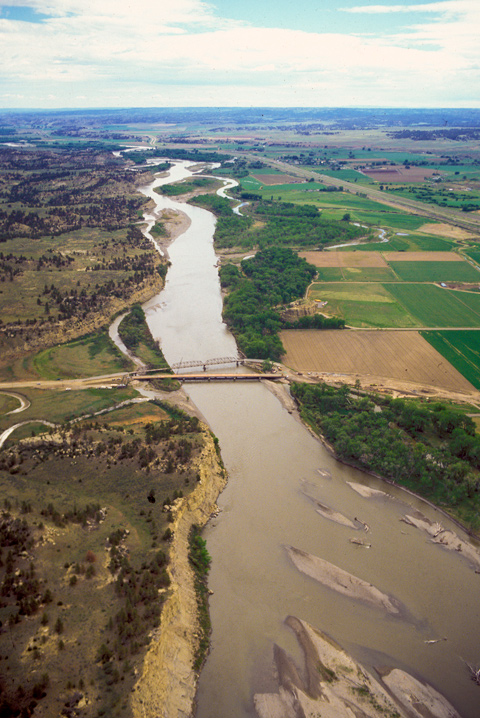Bundy Bridge,Near Pompeys Pillar
East of Billings, Montana
View east, downstream
© 2000 Airphoto—Jim Wark.
In the list of names and descriptions of Indian tribes that Lewis and Clark compiled at Fort Mandan, they called the tribe living along the Yellowstone River, “as usially Spelt and pronounc’d” by the English—and in Clark’s idiosyncratic spelling—”Ravin nation.” Clark wrote the “primitive” name phonetically as Arp-Sar-co-gah, and gave the nickname that “generally obtained among the Canadian Traders” as “Cor beaus” (i.e., corbeaux, French for “the crows” or “ravens”). But the people called themselves Absalookas, sometimes heard as Absarokas, or “Children of the Large-beaked Bird.” Various early white travelers transcribed or defined the name differently, but the Absalookas maintain it refers to the raven.
The Absalookas called the river that flowed past their doors Iichiilika azah, or Elk River. Indians around Fort Mandan called it Meé,ah’-zah, or Stone River. But French-Canadian fur traders who had been on the lower reaches of it in the 1790s had somehow learned to call it the Roche Jaune, or Yellowstone River.
The steel truss bridge was built in 1915. The new bridge, completed in the late 1990s, is still known by the name of Charles Bundy, who settled north of the Yellowstone in this vicinity in the 1880s. Barely discernible in the photo, at the edge of the cottonwood trees just beyond the right (south) end of the bridge, is one of the oldest and most famous landmarks on Lewis and Clark’s route, now known officially, but erroneously, as Pompeys Pillar or, among the Crow Indians, Iish-biia ah-naac’he’.
From Discovering Lewis & Clark from the Air
Photography by Jim Wark
Text by Joseph Mussulman
Reproduced by permission of Mountain Press
Experience the Lewis and Clark Trail
The Lewis and Clark Trail Experience—our sister site at lewisandclark.travel—connects the world to people and places on the Lewis and Clark Trail.
Discover More
- The Lewis and Clark Expedition: Day by Day by Gary E. Moulton (University of Nebraska Press, 2018). The story in prose, 14 May 1804–23 September 1806.
- The Lewis and Clark Journals: An American Epic of Discovery (abridged) by Gary E. Moulton (University of Nebraska Press, 2003). Selected journal excerpts, 14 May 1804–23 September 1806.
- The Lewis and Clark Journals. by Gary E. Moulton (University of Nebraska Press, 1983–2001). The complete story in 13 volumes.


